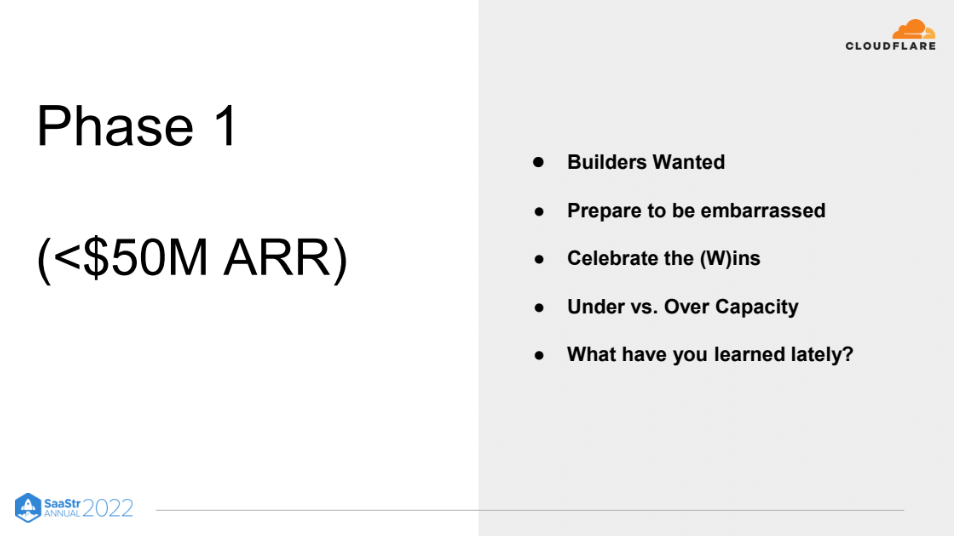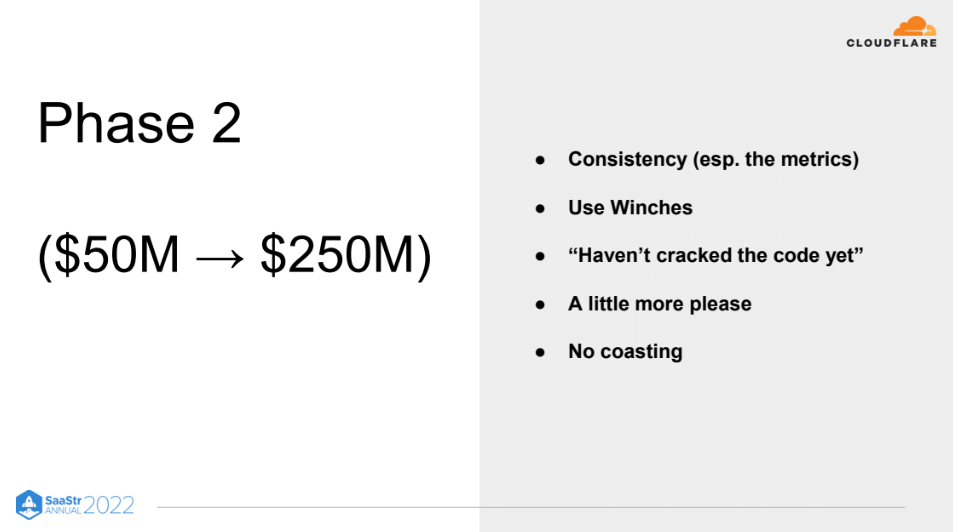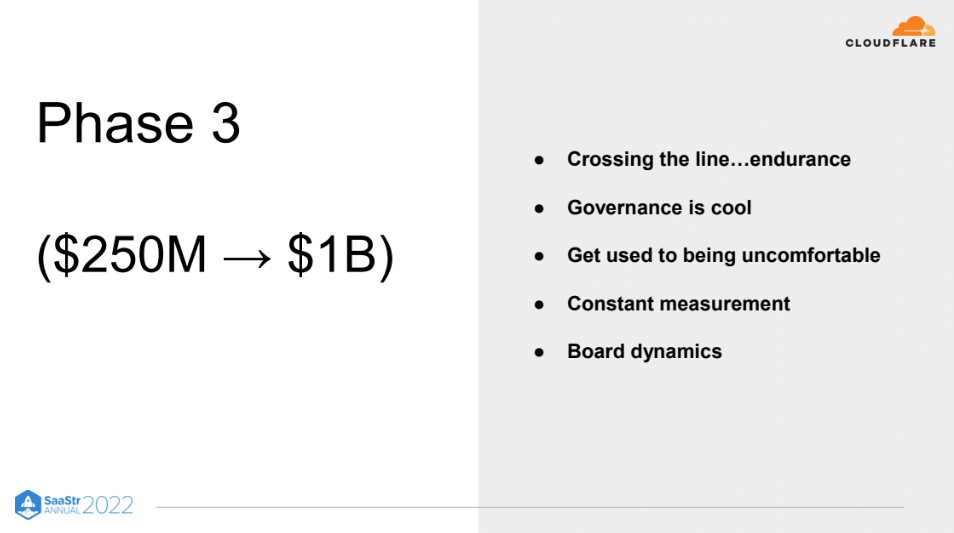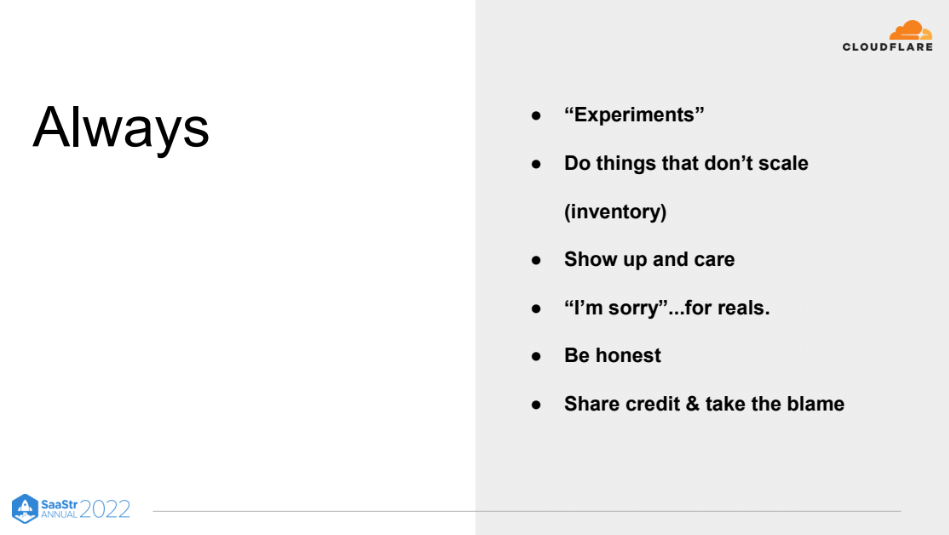Building a sales team that can sustain the exponential SaaS growth needs an expert’s opinion for more granular insights. Chris Merritt, Chief Revenue Officer at Cloudflare, has been with the company for almost a decade. He joined Cloudflare when it was bringing in roughly $1M in ARR. Chris has since grown Cloudflare’s revenue to nearly $1B.
Chris breaks down a typical company’s growth into three phases based on its ARR, providing actionable insights on what you should do and prepare for in each phase.

Phase 1: Less than $50M ARR
Phase 1 is full of uncertainty. You’re not sure if the business will become a long-term success. You don’t have any brand value to attract the best talent that will help you improve the odds of your business’s success either. In this phase, Chris advises companies to look for the “builders” and to celebrate big wins.
- Look for the builders. These are people willing to take challenges head-on and solve problems; people ready to show up and do what it takes to make the business successful. You need builders because you’ll face a new challenge every day. For example, when you’re building the product, there will be times when things don’t work. When you introduce the product to friends, family, or that first group of clients, you’ll be embarrassed often because you might oversell.
- Celebrate big wins. These aren’t the wins of a specific member or team; it’s about the entire company’s successes. Examples include crossing a revenue target or completing an important project. As you keep adding wins to your tally and grow, you’ll need more people. This phase involves a constant tug of war between under and over-capacity. You’ll either need to ask people to do a little more or leave people with some free time. Chris recommends staying under capacity—leaving your team with excess capacity can harm morale.
There’s much to do in this first growth phase, but remember to document your learnings. Learnings come in handy when you’re under pressure. You’ll get asked what you’ve learned on stage and by the board. Having your answers handy will help.

Phase 2: $50M – $250M ARR
At this point of your growth, you’ll need to monitor metrics, focus on your target customer, and stay humble and curious.
- Monitor your metrics. Aim to bring consistency to your metrics tracking and be objective about what the metrics tell you about the business.
- Hone in on your ideal customer. Start focusing on the right type of customers. When you attract customer types that don’t have long-term revenue potential, your revenue won’t sustain and might roll back at some point.
- Stay humble and curious. You won’t always have answers to customer questions. Admit that you don’t have all the answers. Once you accept this and look for answers, you’ll grow. It’s not easy to admit you don’t know something to your customers, staff, or board, so consider how you communicate it. For example, you could say, “I haven’t cracked the code yet.” Moreover, you’ll be asked for more in this phase. For example, when revenue grows at the desired rate, you might still be asked if you can grow a little faster.
“If you’re constantly throwing crap or throwing not-awesome examples of what your business will be long-term into your stack of customers, and they’re attritting, that’s not helpful.”
This phase may sometimes feel overwhelming, but it’s important to remember that you can’t slow down—you need to be ramping up constantly. When you’re taking PTO, relax. When you’re working, go hard.

Phase 3: $250M – $1B ARR
By phase 3, you’re past the uncertainty of the first two phases. The next challenge? Endurance. You’ll need to grow and sustain growth. This stage requires you to embrace governance, lean into the discomfort of leading a successful company, and maintain a positive relationship with your board.
- Embrace governance. You will also have more oversight in this phase. The good news is that governance makes life easy.
“Governance exists to provide a framework so you feel more comfortable as you continue to operate. You can’t see everything, know everything, and deep-dive into everything anymore. Embracing governance will make your life easier.”
- Get comfortable being uncomfortable. As your company scales, you’ll need to solve challenges most people can’t solve. Your days will probably look like a chain of uncomfortable conversations. For example, because every single thing gets measured, you must get used to being judged by your numbers. You have to absorb plenty of information and be aware of the context of what the metrics are measuring.
- Maintain a good relationship with your board. Don’t forget you have to answer to your board. Board members typically include people with a lot of skin in the game, such as angel investors and founders. In this phase, you’ll see a lot of experts and independent board members. Develop a positive relationship with them and remember that things will change over time.

Final thoughts for leaders of growing companies
- Stay passionate about your work.
- Say sorry often and mean it.
- Always be honest and transparent.
- Give credit where it’s due.
- Remember that you’re a leader.

